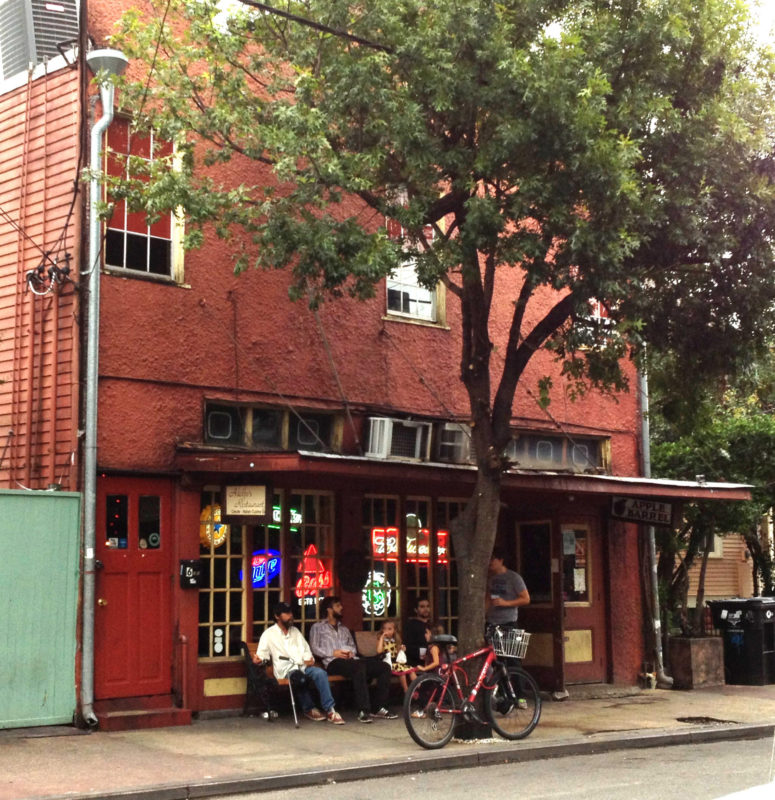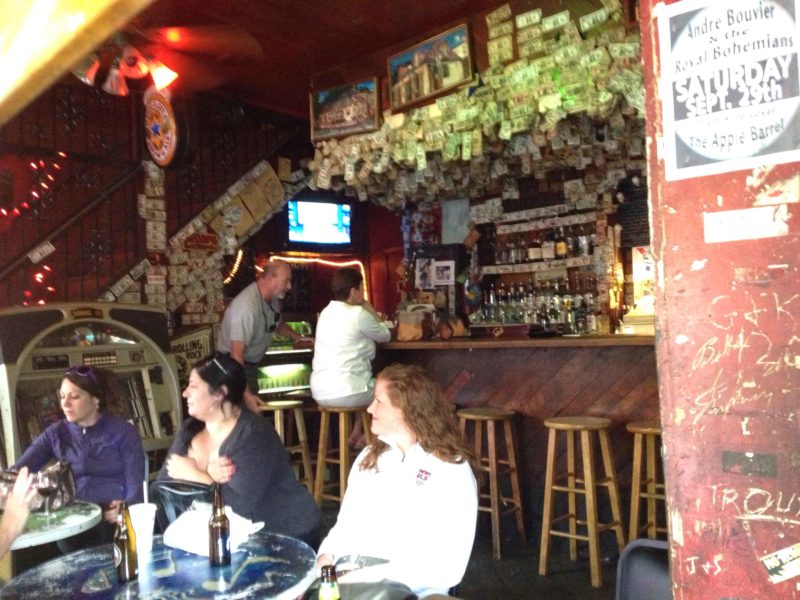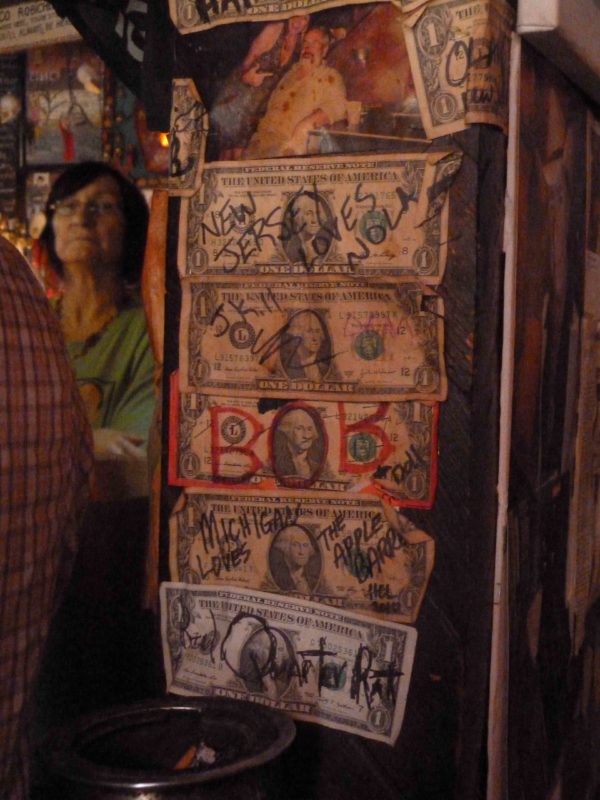Douglas Hopper, Co-owner of the Apple Barrel Bar, said, “Cafe Negril was a bakery. This tattoo shop [next door to Cafe Negril] that was all bakery too. And the D.B.A. was the Marigny Theater and they had little plays and things… The Brassiere on the corner there was a car battery shop and then across Royal Street, but still on Frenchmen, what is the Boys Town, that used to be Home Beverage. They’d deliver cases of bottled soda to your house. On this side of Frenchmen, the Spotted Cat was an oyster house where you shucked oysters and stuff like that; you could still see the troughs on the floor at one time. Next door to us there used to be a disco called Cords Underground, but it blew up at four in the morning. It was a gas explosion or maybe lighting, but no one was hurt. That was around 30 years ago and it’s been an empty lot ever since. We’ve been told this building was a meat market before it was a bar. It’s been in about the last ten years [businesses shifted to music venues], I would say. We’ve been here almost fourteen. We’ve had the bar for fourteen years, but the bar’s been here for longer than that.”

Exterior of the Bar. Photo by Gustavo Rodas
The Marigny Neighborhood and Frenchmen Street
The Marigny neighborhood was established by Bernard Xavier Phillipe de Marigny when he went bankrupt and sold off his plantation in blocks starting in 1806 and continuing into the 1820s. He used his original plantation plot lines to determine the border of the neighborhood, and the former Saw Mill Canal became the central road that is now known as Elysian Fields Avenue (Reynolds, Dean. “History of the Faubourg Marigny.” http://www.faubourgmarigny.org/historyfm.htm. Retrieved 15 October 2012; Branley Edward. “NOLA History: Faubourg Marigny, New Orleans’ First Subdivision.” http://www.gonola.com/2012/11/26/nola-history-faubourg-marigny-new-orleans-first-subdivision.html. Retrieved 15 October 2012). An important piece of the Marigny neighborhood is Frenchman Street, which has always been a commercial corridor closer to the river. However, in the past 10 to 12 years, Frenchman street has become more prominently music-oriented. Snug Harbor, founded in 1964 and The Apple Barrel, founded in the mid-1970s, were the first two music venues on Frenchman Street, featuring performances from mainly local artists. Before the music rush that began around 2000, the rest of the area of Frenchman Street was dotted with more daytime businesses, like the bakery that used to be across the street from The Apple Barrel or the car battery store that was two doors down.
The Building and Ambiance

Interior and Patrons. Photo by Gustavo Rodas
As you approach the Apple Barrel from the south, you notice a faded wall mural covered by graffiti that was once a significant landmark that the city of New Orleans kept clean before Hurricane Katrina. The painting is entitled “Neighborhood Archaeology” by Rain Webb, depicting the landscape of the riverfront and commercial activity of the early to mid-1900s. This mural is an important piece of the experience of the Apple Barrel during the daytime, as the two benches outside the building that are reserved for “customers only” gain importance at night. Customers tend to spill outside because of the size of the interior, and the benches provide a nice place to rest and listen to the music. The interior is a montage of old dollar bills, signatures, and advertisements, except for the stage area, which is backed by a mural of Louis Armstrong.
Above the Apple Barrel is Adolfo’s, a creole-Italian restaurant that is extremely popular locally, and was featured on HBO’s Treme along with the Apple Barrel. The location housed several restaurants prior to Adolfo’s. Adolfo’s is accessible by stair from the exterior of the building and the interior of the Apple Barrel, which makes it highly connected to the atmosphere of the Apple Barrel. The Apple Barrel is built by wood frame construction, which is exposed inside and thus gives the interior a warm, antique, homey feeling. Because of its small size and its openness, the Apple Barrel presents a very welcoming atmosphere that attracts both locals and tourists, very similarly to the nature of New Orleans itself. As one of the owners, Douglas Hopper, describes the area, “A lot of people from out of town here — they come down here and decide to stay.” (Personal interview with Douglas Hopper, Owner of Apple Barrel Bar, 1 Oct 2012).
Regulars and Live Music

Dollar bills hung by patrons over time. Photo by Gustavo Rodas
While tourists visit Frenchman Street mainly for briefly stopping from bar to bar, there is a local culture that involves a more tight-knit group of bartenders, musicians, locals, and business owners. Marco, the lively bartender at the Apple Barrel, has a story for nearly every one of the people who pass by. He, along with Liz Montoya and Douglas Hopper, the current owners, have been a part of the Apple Barrel experience for over 20 years, and have experienced the shift of Frenchman Street over the past 10 years. The bar has live music from 4pm to 4am, featuring many local artists, like the late blues singer and guitarist Coco Robichaux. According to Marco, Coco “used to open up all the jazz festival and everybody knew him. This was his favorite hangout.” (Personal interview with Marco Legorreta, Employee of Apple Barrel Bar, 1 Oct 2012).
The unique flavor of the combination of jazz and blues music played at the Apple Barrel is attractive in the same sense that every individual venue along Frenchmen has its own style, and the combination of these unique experiences is what makes Frenchmen Street and the Apple Barrel irreplaceable.







